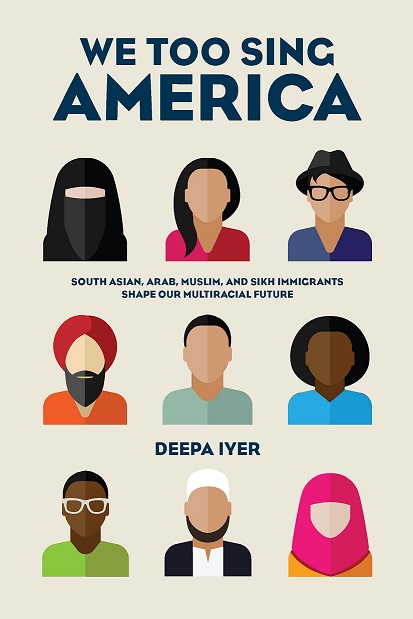 In We Too Sing America (The New Press), nationally renowned activist Deepa Iyer catalogs recent racial flashpoints, from the 2012 massacre at the Sikh gurdwara in Oak Creek, Wisconsin, to the violent opposition to the Islamic Center of Murfreesboro, Tennessee, and to the Park 51 Community Center in Lower Manhattan.
In We Too Sing America (The New Press), nationally renowned activist Deepa Iyer catalogs recent racial flashpoints, from the 2012 massacre at the Sikh gurdwara in Oak Creek, Wisconsin, to the violent opposition to the Islamic Center of Murfreesboro, Tennessee, and to the Park 51 Community Center in Lower Manhattan.
Iyer asks whether hate crimes should be considered domestic terrorism and explores the role of the state in perpetuating racism through detentions, national registration programs, police profiling, and constant surveillance. She looks at topics including Islamophobia in the Bible Belt; the Bermuda Triangle of anti-immigrant, anti-Muslim hysteria; and the energy of new reform movements, including those of undocumented and unafraid youth and Black Lives Matter. Read the following excerpt from Iyer’s book, shared by permission.
Saying No to the Racial Bribe
In America’s changing racial landscape, South Asian, Arab, Muslim, and Sikh immigrants and the organizations that represent them must make the choice every day, time and again, to actively disrupt the racial hierarchy in America and dispel the narratives of cultural exceptionalism. Doing so also involves confronting the systems of White supremacy articulated by Andrea Smith, an intellectual, feminist, and antiviolence activist who identifies as a Cherokee. According to Smith, when an institution, law, or system supports White supremacy, it results in the preservation of benefits, entitlements, and rights to White elites, who then wield greater influence over the political, ideological, cultural, and economic conditions in our nation.
Smith writes, “White supremacy is constituted by separate and distinct, but still interrelated, logics. Envision three pillars, one labeled Slavery/Capitalism, another labeled Genocide/Colonialism, and the last one labeled Orientalism/War, as well as arrows connecting each of the pillars together.” Each of these pillars devalues communities of color by positioning them as exploitable property (Black people’s labor being used without compensation, for example), disposable (indigenous people seen as objects whose histories and struggles can be erased), or inferior subjects to be conquered through hostility, violence, and war (Latinos, Asians, and Arabs).
Given the post-9/11 environment, we could offer another pillar to this framework, one called Islamophobia/National Security that derogates Muslims and anyone perceived to be Muslim in order to preserve the illusion of collective safety. These pillars of White supremacy enable the United States to go to war; to deny people rights to their languages, histories, and homes; to militarize police forces in our cities; and to enact laws that profile, target, imprison, detain, and deport communities of color and immigrants.
At times, non-Black communities of color have colluded, consciously and unwittingly, to maintain White supremacy and its racial hierarchy in place. Our positions on the racial ladder in America dictate the opportunities, privileges, and entitlements that are available to us. Blacks are at the bottom, while Whites maintain the top position. Latinos, Arabs, and Asians fall in middle positions. The racial ladder preserves White privilege while propagating anti-Black racism. Racial groups in the middle maintain and reinforce this structure, sometimes with their consent. For example, immigrants of various racial backgrounds internalize racist attitudes toward Black Americans in the process of becoming “Americanized.” In her 1993 essay “On the Backs of Blacks,” author Toni Morrison explains that “the move into mainstream America always means buying into the notion of American blacks as the real aliens. Whatever the ethnicity or nationality of the immigrant, his nemesis is understood to be African American.” In other words, the process of Americanization and the journey toward cultural or legal citizenship inevitably includes accepting, internalizing, and perpetuating racist ideas and narratives of African Americans.
As our country’s demographics change, our positions on the racial ladder will be cause for even greater anxiety. In order to maintain the position of groups in the racial hierarchy, we can expect to see efforts that expand the category of White to buttress the numbers of Whites and to convey the false impression that Whiteness can include racial diversity — that is, the claim that Whiteness could be based not merely on phenotypical racial identity but also on supposed nonracial factors that signify social and political power, including the attainment of higher economic and educational status. This creeping Whiteness inevitably means that some people of color will be invited to join the White category, with the promise of attaining the privileges of Whiteness. South Asians, Arabs, and other Asians have historically been tempted to take this racial bribe in order to advance to higher positions on the racial hierarchy. We must firmly decline this invitation. When we do so, we can begin to dismantle the racial ladder altogether.
* * *
Read about the discussion with Iyer at a San Francisco book event for We Too Sing America.
Deepa Iyer is a national figure in movements for racial and immigrant justice in America. She served as executive director of South Asian Americans Leading Together (SAALT) for a decade. Iyer is currently the Senior Fellow at the Center for Social Inclusion where she addresses issues of structural racism and multi-racial solidarity building in American’s changing racial landscape. Iyer honed her legal and policy skills at the Civil Rights Division of the U.S. Department of Justice, the Asian Pacific American Legal Resource Center, and Asian Americans Advancing Justice.












